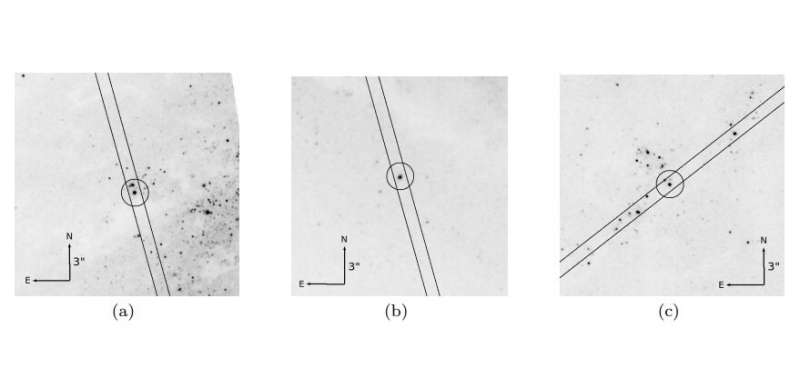Images in HST/F555W: (a) NGC 4736 1, (b) NGC 4736 2, and (c) NGC 4736 3. The circles mark the central objects (a) with the radius of 1.1”, it is the maximum seeing on the ground-based images, the 1” slit is shown. Credit: Solovyeva et al., 2019.
Russian astronomers have identified three new luminous blue variable (LBV) candidates in the star-forming galaxy NGC 4736. While one of the three newly found candidates was confirmed to be an LBV, the nature of the remaining two remains uncertain. The discovery is presented in a paper published January 16 on arXiv.org.
LBVs are rare and unstable, evolved massive stars at one of the final evolutionary phases. They exhibit strong photometric and spectroscopic variability related to transient eruptions. Studies of LBVs and eruptions taking place in these objects could provide more insights about stellar evolution of massive stars.
To date, only about 40 LBVs are known in our Milky Way galaxy and in the galaxies of the Local Group. Notably, searching for LBVs in the galaxy is difficult due to high extinction in the galactic plane and uncertain distance measurements, while finding such stars in nearby galaxies could be easier, since the distances to them are determined more reliably.
With the aim of detecting new LBVs, a team of astronomers led by Yulia Solovyeva of Special Astrophysical Observatory in Nizhnij Arkhyz, Russia, conducted a search for the presence of hydrogen-alpha emission in blue point-like star objects in the NGC 4736 galaxy. Discovered in 1781, NGC 4736 (also known as Messier 94) is a star-forming spiral galaxy in the constellation Canes Venatici, located some 1.3 million light years away from the Earth.
Solovyeva's team studied archival images obtained by NASA/ESA Hubble Space Telescope (HST) to identify three new LBV candidates. Afterward, they analyzed the spectral and photometric variability of these objects using various ground-based telescopes, including the BTA-6 telescope at the Special Astrophysical Observatory in Russia. This allowed them to find that all the three sources have spectra similar to the spectra of the known LBVs.
"We have found three new LBV candidates in the star-forming galaxy NGC 4736. They show typical well-known LBV spectra, broad and strong hydrogen lines, He I lines, many Fe II lines, and forbidden [Fe II] and [Fe III]," the researchers wrote in the paper.
According to the study, the candidate designated NGC 4736_1 has an absolute magnitude of –10.2 mag, a bolometric magnitude of –11.5 mag, and a bolometric luminosity of about 6.5. Moreover, this source showcases a significant brightness variation. The properties of this object allowed the astronomers to conclude that it is indeed an LBV star.
"Based on its spectrum typical of the LBV, the characteristic bolometric luminosity and considerable brightness variations, we conclude that NGC 4736_1 is actually the LBV star," the paper reads.
Other candidate - NGC 4736_2 – was found to have lower limits of the absolute and bolometric magnitudes of –8.6 and –10.0 mag respectively. The bolometric luminosity of this source was calculated to be at a level of at least 5.9. However, given that NGC 4736_2 exhibits a relatively small brightness variation, it puts into question its LBV status.
When it comes to NGC 4736_3, it has the absolute and bolometric magnitudes of –8.2 and –8.4 mag respectively, and a bolometric luminosity of around 5.3. However, insufficient photometric data does not allow the researchers to estimate brightness variation of the source, leaving NGC 4736_3 classified as an LBV candidate.
More information: Y. Solovyeva et al. New Luminous Blue Variable Candidates in NGC 4736. arXiv:1901.05277 [astro-ph.SR]. arxiv.org/abs/1901.05277
© 2019 Science X Network
























